/ How to treat gout with medication
Cure for gout
Gout Is a disease that affects the joints due to the deposition of uric acid salts. The disease has a relative prevalence - only three out of a thousand people are likely to get it.
It usually develops after 40 years, and affects both men and women with the same frequency. The joints that are most susceptible to damage are located on the toes of the feet.
There are several factors that increase the risk of developing gout:
- diabetes;
- hypertension;
- hereditary factor;
- unbalanced diet.
Thus, we can conclude that gout develops in those who have an unbalanced balance of substances in the body.
To understand how to treat gout with medications, you need to find out its symptoms.
Symptoms of Gout
The disease appears suddenly, and is accompanied by severe pain. The patient feels heat in the joint, and this usually happens at night. The sensitivity of the joint at this point is so high that even under the weight of a light sheet, severe pain can develop.
Subsequent attacks have a slightly different course: before the sensation of heat and severe pain occurs, the patient feels a tingling sensation in the joint area.
If untreated, seizures occur more often, and the disease affects new joints. Often, a running process becomes the cause of pathology of the kidneys and urinary tract.
Before choosing medications for the treatment of gout, it is worth understanding what processes occur in the body in connection with this disease:
- The level of uric acid in the blood rises.
- There is an accumulation of uric acid compounds in the body.
- Uric acid compounds are deposited in tissues and organs.
- Gouty cones and granulomas develop around the joints.
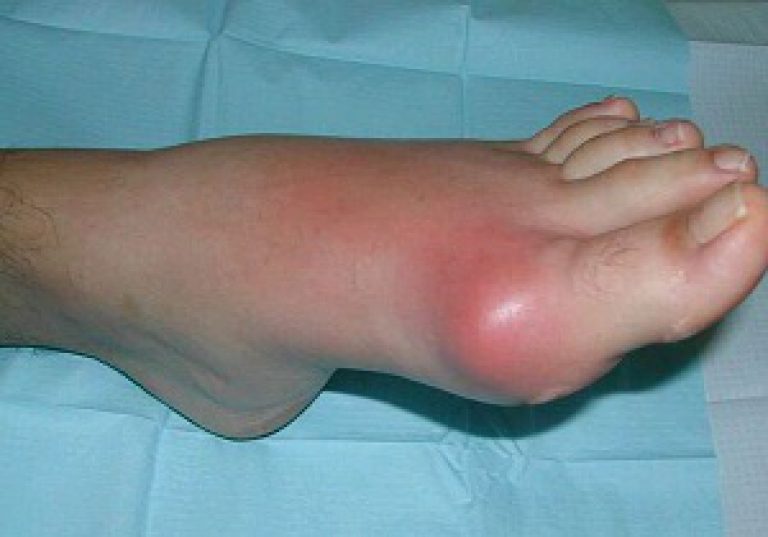
It is impossible to completely get rid of gout, but to slow down the development process and make life easier for the patient during seizures in the possibilities of modern medicine.
The best cures for gout
The medications used for gout on the legs and other parts of the body are few - just a few groups of medications.
Medications Used During Attacks
So, the first cure for gout is colchicine, which affects uric acid metabolism. This is a gout medication of direct action based on colchicum. It relieves pain and has an analgesic effect, and also reduces the migration of leukocytes to the affected area, inhibits the formation of microcrystals of uric acid and prevents their deposition in tissues. Thus, the medication is aimed not only at preventive - promising treatment, but also situational, thanks to the anti-inflammatory effect and analgesia.
The medication should not be used for kidney and liver failure. If it is taken for a long time, then there is a threat of leukopenia and anemia.
The effect of the drug is observed in the first 12 hours after administration, provided that it is taken at the beginning of the attack. If you start taking it late, then there will be no positive result from treatment, or it will be inconspicuous. The medication is effective in 90% of cases.
Among modern medicines for gout are NSAIDs. In these cases, two series of medicines are widely used:
- pyrazolone - Reopyrine, Butadion, Phenylbutazone, Ketazole;
- indole - Indomethacin, Metindol.
These new gout medications during seizures are better tolerated than colchicine, and also give a more pronounced therapeutic effect.
Voltaren is also often used to relieve gout attacks. The first dosage - shock, is 200 mg per day, and then it is prescribed in a smaller amount - 150 mg per day.
All of these medicines are for treating seizures. The following drugs are used to treat a chronic form.
Gout Medications for Long-term Use
For long-term use, a medicine for gout Allopurinol is suitable. It is aimed at reducing the level of uric acid in blood plasma and is available in tablets of 0.1 and 0.3 g.
Treatment is started in small doses to avoid exacerbation of the disease and prevent an allergic reaction. The medication is not prescribed during seizures - before taking Allopurinol 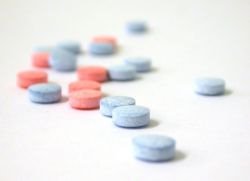 it is necessary to achieve a stable calm state of the joint. In most cases, the drug is well tolerated.
it is necessary to achieve a stable calm state of the joint. In most cases, the drug is well tolerated.
In addition to Allopurinol, analogues can also be used for treatment:
- Thiopurinol;
- Probenecid;
- Antoran;
- Benzobromarone;
- Hipurik;
- Losartan.
womanadvice.ru
What medications can help cure gout?
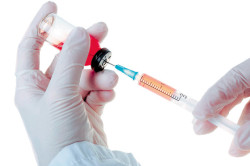
Gout is a joint disease that has been described by ancient scholars. Long-known medicines and new drugs are used to combat it. Gout treatment is usually carried out in two stages.
- First, they eliminate pain, then relieve swelling. In this case, redness comes off from the areas damaged by the disease. Thus, they remove the inflammatory process during an attack. Treatment is carried out until the symptoms disappear.
- The next step is to use a cure for gout, which helps lower uric acid levels in the blood and reduces the frequency of seizures. In order for the disease to recede, the drug should be taken for several days or weeks after the next exacerbation of the disease.
The duration of the course depends on the level of uric acid in the blood. In some cases, a cure for gout will have to be taken for several years.
Features of therapy for gout
For the treatment of gout, a combined method of using medications is used. With a short-term therapeutic course, medications are prescribed that relieve pain and inflammation in a severe attack of the disease. For these purposes, the patient is prescribed non-steroidal drugs, and not aspirin, which can lead to an exacerbation of the disease. During this period, colchicine is used, which can be recommended with a long course of therapy.
Corticosteroids are sometimes indicated, which are sometimes injected directly into the affected joint. This is necessary when other drugs do not act on the patient or are contraindicated. Many gout medications cannot be used if the patient suffers from chronic kidney failure, various gastrointestinal diseases with bleeding.
With long-term treatment, drugs are used that lower the level of uric acid in the blood and remove it from the body through the kidneys. Allopurinol is used to reduce the production of this substance. A medicine like colchicine will help reduce the number of seizures. It is also taken as a preventive measure to prevent an undesirable exacerbation of the disease.
If treatment is started in a timely manner, relief from an attack may come within a day. For this, the doctor prescribes a single dose of the maximum dose of one or more drugs. Subsequently, the amount of drug taken is reduced.
All drugs that lower uric acid levels have many contraindications. Therefore, the doctor and the patient must be sure of the correctness of the diagnosis. The patient should not use aspirin to reduce pain, it can only increase seizures.
Drugs for the treatment of the disease
All over the world there are many drugs that are supposed to be used to combat gout. To eliminate the increase in the amount of uric acid in the blood, the use of the following drugs is recommended.
- Losartan. It also uses to combat hypertension.
- Fenofibrate. It affects some fats in the blood and helps to remove uric acid from the body.
- Uratoxidase Has the same effect as the above drug.
- Febuxostat (Y-700). Affects the amount of uric acid produced by the patient’s body.
These drugs are used if the doctor for some reason cannot prescribe allopurinol to the patient. It is also worthwhile to study the effect of three drugs, which are most often prescribed to patients suffering from gout.
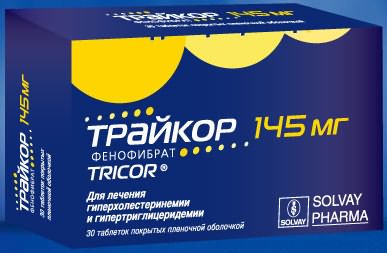
Fullflex is a cure for gout and is used to eliminate the symptoms of myalgia, rheumatism, osteochondrosis, various types of arthritis. It has anti-inflammatory effect. Helps to eliminate pain during an attack of gout and removes uric acid from the body. It is prescribed to patients in the form of capsules or cream. Take it for a month, 1 tablet per day. The cream should be rubbed 2 times a day. Contraindicated in pregnancy and lactation.
Allopurinol as a medicine for gout is used to combat the increased amount of uric acid in the blood and in the presence of complications caused by this. It is prescribed to patients in the form of tablets. The daily norm for gout is 0.1-0.2 g. If the disease is of moderate severity, the dose is increased to 3-4 tablets (0.3-0.4 g). A decrease in uric acid level occurs after 1-2 days. The drug has no analgesic effect, but can reduce the number of gout attacks.
This tool is contraindicated in case of impaired liver function and during pregnancy. The main side effects: headache and dizziness, depression, general weakness, hematuria, nausea, diarrhea, vomiting. Symptoms of arterial hypertension or bradycardia, stomatitis are possible. If you are hypersensitive, you should immediately stop taking the drugs and consult a doctor who will pick up another drug.
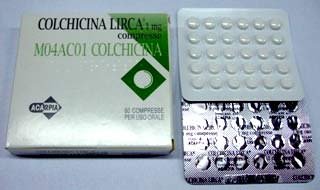
A gout medicine called colchicine is used. It has a very strong analgesic effect and is used to eliminate the symptoms of an acute attack. The drug is absolutely harmless to the body, as it is of plant origin. Available in tablet form. Used during the next attack of the disease. Dose - 1 mg. After taking the first pill after 2 hours, you need to drink the second - this eliminates joint pain, for example, with gout on the legs. The patient feels significant relief 3 hours after taking the first dose, and it can last for 12 hours.
Colchicine is also used to prevent the disease. Contraindications to its use: renal or pulmonary failure, high sensitivity to the components of the drug. During pregnancy, its use should be strictly controlled by a doctor. Side effects colchicine: nausea, vomiting, the development of diarrhea, burning on the skin or urticaria, the appearance of muscle dystrophy. In men, a decrease in sperm count is possible. If such phenomena occur, you must abandon the use of the drug.
The use of any medicine before consulting a doctor is strictly prohibited. Only a specialist can make an accurate diagnosis and choose drugs taking into account the course of the disease and the individual characteristics of the patient's body.
MoiSustav.ru
Medicines for gout: what to choose the many available remedies?
Drug therapy plays a leading role in the treatment of gout. But physiotherapy, spa treatment, traditional medicine play only an auxiliary role. Moreover, the selection of drugs should be carried out by a rheumatologist, taking into account the phase of the disease and possible contraindications. And, before deciding what the cure for gout should be, it is worth briefly dwelling on the pathogenesis and clinic of this disease.
General principles of drug treatment
The development of gout is based on the accumulation of uric acid compounds, urates, in the body. Clinically significant manifestations of this disease are specific inflammatory processes in the joints - gouty arthritis. A few years after the development of arthritis, tofuses are formed - accumulations of urates in the form of subcutaneous nodules with localization in the area of \u200b\u200bthe auricles, joints, legs, and forearms. With advanced forms of gout, damage to the internal organs and the development of chronic renal failure are possible.
Comprehensive treatment of gout with medicines has the following goals:
- Uric acid metabolism correction
- Relieve gouty arthritis
- Tofus Treatment
- Renal failure prevention
In this regard, drugs of various groups are used - tableted preparations, ampoules for injection, ointments for external use.
Correction of metabolic processes
The effect on the metabolism of uric acid in gout involves the termination of its intake in the body, the inhibition of its synthesis, and the strengthening of its excretion in the urine. The cessation of urate intake is achieved through an appropriate diet, and medications are not used here. Preparations from the group of uricodepressants interrupt the sequence of certain biochemical reactions, as a result of which the formation of uric acid is inhibited. For this purpose, use tablets from gout - Allopurinol, Thiopurinol, Allomaron. The latter remedy has a complex effect - reduces synthesis and enhances the excretion of urates.
Uricosuric drugs promote the release of urate in the urine. Conventional diuretics in this case are not only ineffective, but also contraindicated. Urokosuricheskoe action possess Urodan, Urolesan, Benzobromaron, Ketazon. It should be noted that the accumulation of urates may complicate some other diseases - coronary heart disease, diabetes mellitus, thyrotoxicosis, some bacterial and viral infections. Effective treatment of these diseases will inevitably lead to a decrease in uric acid levels. It should be noted that the use of uricodepressive and uricosuric agents does not always alleviate the course of gouty arthritis. For example, Allopurinol is ineffective for the treatment of exacerbation of gout.
Arthritis Treatment
An exacerbation occurs in the form of gouty arthritis with typical symptoms - swelling, pain, stiffness of movements. Best remedy goth gout in such cases - colchicine. This medicine affects the deposition of uric acid crystals in the joints and inhibits the release of biologically active substances responsible for the course of inflammatory reactions. Ultimately, pain and range of motion are eliminated for gouty arthritis.
And we advise you to read: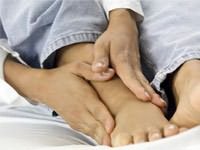
Other gout medications have a similar effect - non-steroidal anti-inflammatory drugs (NSAIDs). These agents have a direct anti-inflammatory effect, and some of them, for example, Butadion and its derivatives, also have a uricosuric effect. True, not all NSAIDs are indicated for gout. Derivatives of Acetylsalicylic acid have the opposite effect - they prevent the removal of urates, and therefore are contraindicated in this disease.
In general, it is advisable to use NSAIDs for the treatment of gout in combination, in various dosage forms. At the same time, tablets and gout ointment containing Diclofenac, Indomethacin, Ibuprofen are used. Naproxen and other NSAIDs. Using these drugs, one should not forget about their negative effect on the function of the liver, stomach and intestines. But these organs are already provoked with gout. Other anti-inflammatory drugs, steroid hormones (Hydrocortisone, Diprospan, Kenalog), are injected directly into the joint cavity. But these drugs are used only in extreme cases, when a pronounced inflammatory process has led to the accumulation of a large amount of intraarticular fluid.
Treatment of late complications
Tofuses are formed several years after the first exacerbation of gout. In most cases, they are painless. Although in some cases, increasing tofus, localized in the projection of the joints, can complicate the course of gouty arthritis. Nevertheless, they should not be opened on their own, they should not be punctured. With timely comprehensive anti-gout treatment, they themselves decrease. Sometimes these specific granulomas can be opened independently. The opened tofus is treated with antiseptics. For this, Dimexide, iodine-containing products, any ointments containing antibiotics are suitable.
Chronic renal failure (CRF) is an extremely undesirable complication of gout. To avoid chronic renal failure, heavy drinking and periodic infusion (intravenous infusion) of alkalizing solutions are recommended. Alkalization prevents the deposition of urate stones in the renal pelvis. For this purpose resort to infusions of sodium bicarbonate (soda), various electrolyte solutions. These solutions, as well as other drugs, should be used under close laboratory supervision. In the course of laboratory tests of blood and urine, the acid-base state, the number of excreted urates are evaluated. Therefore, all patients in the phase of exacerbation of gout should be observed by a rheumatologist in a hospital.
MoyaSpina.ru
In case of damage to several joints, non-steroidal antibiotics are prescribed.
If the disease has gone far, the doctor may prescribe stronger drugs that reduce swelling and suppress urea synthesis:
- Glucocorticoid
Acute Gout Attacks removed by injection directly into the joint. An injection is done once, but in some cases it needs to be repeated.
If diseases associated with metabolic disorders (e.g. diabetes) are identified, the doctor determines the treatment regimen for these diseases.
Fighting excess uric acid
To limit the concentration of uric acid in the body:
- Small doses of aspirin to suppress uric acid secretion.
- Butadion has a moderate effect, side effects are possible.
- Antoran today is the most effective drug. It significantly reduces the presence of uric acid in the blood. In 2-3 weeks, full normalization is possible.
- Ketasone in parallel has an anti-inflammatory and analgesic effect.
- Benemid is widely recognized as a very effective remedy. It can be used for a long time constantly. Breaks are prescribed up to 5 months in case of a prolonged therapeutic effect.
- Atofan is able to relieve an acute attack. But it is used very carefully because of side effects.
- Urodan increases the solubility of uric acid formations.
Physiotherapeutic methods
A modern treatment for foot gout involves electromagnetic exposure or electrophoresis. Using electric microcurrents, the formed salts are destroyed, and uric acid is excreted from the body. The most modern method of blood purification is the use of a special apparatus, “Plasmoforezogemosorption.”
Another progressive method for treating gout and relieving seizures is cryoapheresis. It is based on the use of low temperatures affecting the blood and its constituent elements. This method:
- preserves and returns to the bloodstream cellular elements and nutrients in the maximum amount,
- at the same time removes uric acid and other components of the final chain of metabolism from the blood plasma to be removed from the body.
As an auxiliary method, treatment in the sanatorium and in the resort acts. In these places, there are all the possibilities for a full range of physiotherapy, including massage and physiotherapy exercises.
If the course of the disease becomes especially severe, resort to surgical removal of the growths of the diseased joint.
Treatment with folk remedies
Decoctions and infusions
To remove excess urea from the body, traditional medicine advises drinking decoctions and infusions, for example:
- Infusion of lingonberry leaves. A glass of boiling water is poured into 20 g of leaves. Insists half an hour. Drink several times a day in a tablespoon.
- Juice of a dioecious nettle to take three times a day for 1 tsp.
- Decoction from the leaves of drooping birch. For two glasses of boiling water, two tablespoons of leaves. Boil for 10 minutes and insist for half an hour. After straining, drink a quarter cup while eating.
- A decoction of garlic and lemon. Highly effective remedy. Skip four lemons through a meat grinder, chop three cloves of garlic. Pour the mixture with boiling water (7 glasses) and leave for 24 hours in a darkened place. Take in the morning before meals 3 tbsp. l
Baths and compresses
A good result is obtained when treating gout with herbal baths. They can be prepared from:
- sage leaves
- oat straw.
It is useful to soar your feet in a hot solution with laundry soap (grate half a piece) and salt (half a pack).
A simple and effective compress is prepared from 250 g of salt, which should be boiled in 100 g of water until the water evaporates. Then, medical vaseline (200 g) is squeezed into the salt, and everything is mixed. Put a warm compress on sore feet and keep overnight.
A good treatment for painful cones on the toes is a compress from pharmacy medical bile. After 15 procedures, the pain goes away. And as a result of 40-45 procedures, the cone resolves.
A more complex composition of the compress from medical bile (1 bottle) involves the addition of camphor alcohol (160 g), red hot pepper (1 tbsp. L.). The composition in the bank should stand for a week in a dark, cool place.
Independent actions
Short-term measures
Sometimes the pain is relieved by applying ice to a sore joint. In other cases, dry heat is more effective (e.g., blanket, heating pad). But these funds briefly remove the manifestations of the disease.
The role of nutrition correction
A good result in the treatment of gout gives a diet. With its help, you can significantly reduce the level of urea in the body. We must not forget about fasting days.
Fluid intake
You need to drink up to three liters of fluid per day:
LechimSustavy.ru
Gout is a disease in which the metabolism is disturbed in the tissues of the joint, which leads to the deposition of salts and the accumulation of uric acid, with a further restriction of the mobility of the joint bag.
Gout Treatment
It should be remembered that gout in its neglected form poses a danger to the condition of the genitourinary system and can lead to disruption of the kidneys. In the treatment of gouty arthritis, medications play a leading role in recovery. In the acute stage of the disease, the main task of using the drug is to relieve pain in the affected joint. In remission, drugs are used to reduce the level of uric acid in the joints.
Acute Gout Treatment
The acute stage of the disease usually lasts 1-2 weeks. It is advisable to monitor the patient in the hospital during this period. To relieve pain attacks of the disease in the acute stage, non-steroidal anti-inflammatory drugs are used. In a hospital, injections of anti-inflammatory drugs are used, as this method of drug administration ensures that there are no side effects that may occur when taking drugs orally. A set of measures aimed at stopping the attack, usually consists of the following procedures:
- the appointment of non-steroidal or corticosteroid drugs (Diclofenac, Nimesulide);
- bed rest;
- strict diet and heavy drinking.
Treatment of gout in remission
After relieving pain attacks in the acute stage, therapy is prescribed with the help of drugs that improve the metabolism in the joint and excretion of uric acid. In the complex of medical treatment, drugs are used that have different effects on the patient's body:
- drugs that reduce the production of uric acid salts (Allopurinol, Hepactocatalase);
- uric acid excreting drugs (Flexin, Urodan).
Gout medications and methods of use
In the treatment of gouty arthritis, a complex of drugs is used, each of which is prescribed by a doctor, depending on the severity of the disease and the appropriateness of their use. According to the method of use, drugs can be divided into 4 groups:
bolit-sustav.ru
The most effective cure for gout can only be prescribed by your doctor.
Gout is a disease of bones and joints in which salts are deposited in them. This disease has been around for many years. The first mention of gout was discovered during the time of Hippocrates. She was hurt by a lot of people, including the great ones: Ivan the Terrible, I.S. Turgenev, C. Darwin, and others. Symptoms of the disease are unpleasant. Attacks of the disease begin at night and manifest as redness and swelling of the foot joints, severe pain and high temperature up to 40 °. Possible disruption of the digestive system.
Gout and its complications
Gout is a disease in which a metabolic disorder occurs, because of this there is a deposition of uric acid salts in the joints and bones. The reason is a high level of uric acid in the blood. In the joints, a gradual formation of small particles occurs, which leads to the destruction of the joint. The presence in the body of a large amount of such acid can be caused by kidney diseases or their weak work.
One of the signs of gout that has begun is the formation of painful growths on the legs or arms. If the growths burst, the patient may notice small white particles in these places - crystals of uric acid salts.
Usually a gout attack lasts no more than a week and then passes by itself. It used to be that men over 40 are most at risk for this disease. But recently, the disease has been developing at a high rate in both women and men, and of different ages. The cause of gout often lies in the wrong lifestyle and unhealthy diet.
Prescribing drugs and special procedures are carried out by the attending physician, but even doctors believe that it is impossible to completely cure this ailment. In order for symptoms to manifest themselves less frequently and less severely, not only the prescribed treatment helps, but also a change in lifestyle. In addition to prescribing pills, the doctor recommends that his patients change their diet, start exercising, avoid sudden changes in temperature and use some folk recipes.
If treatment for gout is not started on time, a complication such as gouty arthritis can occur, in which tofuses appear. Tofus are salt deposits in the connective tissue. The most common place for the formation of tofus is the auricles, but if the necessary treatment is not carried out, new growths form on many organs, including the internal ones. Sometimes it is very difficult to detect them. In addition to gouty arthritis, urolithiasis can occur.
When choosing medications for gout, the doctor always takes into account that their action should be comprehensive and comprehensive. Such medicines should meet the minimum requirements:
- in a short time to alleviate the patient’s condition, relieve pain;
- prevent the development of new attacks;
- prevent the development of complications.
If the doctor has correctly identified the causes of the disease, then it will be much easier to choose medications for gout. Considering all aspects, an integrated and well-grounded treatment regimen will be drawn up.
Indications for the use of medicines for gout
As we have already said, with gout, they use combined diverse therapy.
If the doctor intends to take a short treatment course to relieve the painful symptoms of gout, then the effect of the drugs should be aimed at eliminating pain and inflammation during the attack. In such a situation, as a rule, non-steroidal medicines are prescribed (except acetylsalicylic acid).
Intramuscular injections are often prescribed if administering the drug in another way is impossible or difficult (with diseases of the digestive system, internal bleeding, diarrhea, vomiting, etc.).
For a long-term treatment, agents acting on a larger scale are used: for example, they reduce the amount of uric acid in the circulatory system, facilitating its excretion from the body through the urinary system. Similar drugs can be used to prevent relapse of gout.
Release form
Gout injections are often prescribed during the period of exacerbation, since the injection form helps to quickly get rid of pain, because the medicine immediately enters the bloodstream. In especially severe cases, with pronounced pain syndrome, the injection of the drug can be carried out directly into the joint - that is, into the focus of inflammation.
Gout tinctures are also a popular remedy. However, before taking the tincture inside, it should be borne in mind that alcohol-based products, as well as alcoholic beverages, with gout are extremely undesirable. Tincture is best used externally: for rubbing or compresses.
Decoctions for gout can be taken orally or used for bathing. By the way, bathtubs perfectly relieve pain and soothe sore joints. Water for the procedure should be warm and comfortable for the patient.
Homeopathy for gout usually involves the use of herbal solutions in a special dilution, which are taken in the form of drops or sublingual tablets. Such drugs are taken for a long time, 1-1.5 months, more often - before meals. Homeopathic remedies act cumulatively, gradually stimulating the body's own forces to fight the disease.
Antibiotics for gout are prescribed to eliminate the inflammatory process. They can be used in the general therapeutic regimen, both in the form of tablets, and in the form of injections (intramuscular or intraarticular).
The form of the drug is selected, as a rule, taking into account its effectiveness in each case. At the same time, the individual characteristics of the patient and ease of use are taken into account.
Gout Medication Names
Drugs that inhibit the formation of uric acid or affect its metabolism:
- Allopurinol - this drug acts on the original cause of gout, normalizing the level of uric acid in the bloodstream and body tissues. Inflammation is not eliminated, but regular attacks and exacerbations of the disease cease. The drug is taken in an amount of from 100 to 300 mg per day according to an individual scheme. Usually, treatment lasts at least 2-3 weeks;
- Colchicine is a herbal preparation based on colchicum extract. The drug alleviates the painful syndrome, especially if taken on the first day of the acute period. In this case, it is taken every 60 minutes at 0.5 mg. At a time, no more than 1 mg of Colchicine is allowed;
- Fullflex is a natural multicomponent drug, which is available in the form of capsules or external ointment. It is successfully used to eliminate inflammation and pain, as well as to lower cholesterol and uric acid. Fullflex is considered one of the safest cures for gout, as it contains only natural ingredients. The drug is taken in the amount of 1 capsule per day for at least a month. Fulflex ointment is rubbed in the morning and at night;
- Blemaren is a means for dissolving urinary deposits, which simultaneously increases the level of urinary fluid pH. Blemaren is prescribed in the amount of 2-5 tablets per day, by dissolving them in a cup of water or another drink. The daily dose should be taken in three divided doses, at the same time intervals;
- Veroshpiron is a drug that belongs to diuretics - diuretics from the range of spironolactone. The medicine takes part in the inactivation of the inflammatory process, the removal of edema and the removal of excess uric acid from the circulatory system. The average daily dosage of the drug is 100-200 mg 1-2 times a day. In childhood, the drug has been used since 5 years;
- Cyston is a cure for gout that can dissolve urinary deposits. The basis of the drug is herbal. Cyston can be taken three times a day for 1-2 tablets. Treatment is usually long, for several months in a row. In pediatrics, the drug has been used since 12 years.
Pain relievers for gout:
- Ketorol is a strong enough pain reliever that can be prescribed as tablets or injections. The dosage of the drug is selected individually, but you should be aware that taking this medication for more than 4 consecutive days is undesirable;
- Dimexide is an anesthetic based on dimethyl sulfoxide. The active component penetrates perfectly into the tissues when applied externally, providing an anti-inflammatory, analgesic, antiseptic effect. Dimexide is used mainly for compresses (1 time per day - about half an hour). Dilution of the solution for the preparation of a compress - from 30 to 50%. Sometimes irritation and burning may appear at the site of application of the drug.
Anti-inflammatory for gout:
- Movalis is a non-steroidal drug of the meloxicam group. The use of the drug can alleviate the acute manifestations of an attack of gout. Movalis is prescribed in the form of intramuscular injections of 15 mg daily, for 2-3 days. The decision on the further use of the drug is made by the doctor. Long-term treatment with the drug is undesirable;
- Ibuprofen is a well-known non-steroidal drug that simultaneously has anti-inflammatory and analgesic effects. The drug is taken 4 times a day, 800 mg each, if possible after a meal;
- Voltaren is a drug that is used to eliminate pain attacks with gout. At the very beginning of treatment, Voltaren is taken in an amount of 200 mg, then lowering the dose to 150 mg per day. At the same time use an external tool for rubbing the joints;
- Meloxicam is a well-known anti-inflammatory and anti-rheumatic drug that is used for short-term treatment of acute manifestations of gout. The drug can be prescribed to patients from the age of 18, in a dosage of 15 mg once a day, in the form of intramuscular injections;
- Diclofenac is a common anti-inflammatory drug that is prescribed in an amount of up to 200 mg daily. Diclofenac should not be used for a long time, especially with diseases of the digestive tract: colitis, enteritis, gastritis, and gastric ulcer. Diclofenac can be prescribed in the form of injections, tablets, topical preparations;
- Indomethacin is a non-steroidal ointment with a pronounced anti-inflammatory, analgesic and decongestant effect. It penetrates deep into the tissue at the site of application. The ointment is usually applied up to 3 times a day, rubbing lightly. The therapeutic course should not exceed 10 consecutive days. In some cases, the simultaneous use of indomethacin tablets may be recommended;
- Nise is a non-steroidal anti-inflammatory tablet with the active ingredient nimesulide. The drug relieves pain, normalizes temperature and relieves swelling. Nise is prescribed for oral administration of 1 tablet in the morning and evening. Do not take pills for inflammatory processes in the digestive system;
- Prednisone is a glucocorticosteroid, tablets for internal use. They have a pronounced anti-inflammatory effect, blocking the development of inflammatory signs. The average dosage of prednisolone is up to 60 mg per day. During an exacerbation, the amount of the drug can be increased at the discretion of the doctor;
- Aertal is a non-steroidal anti-inflammatory ointment based on aceclofenac. The drug will help eliminate swelling, redness in the joint, regardless of the etiology of the inflammatory process. Ointment is used three times a day on the area of \u200b\u200bthe affected joints, it is possible under a light bandage;
- Nimesil is a remedy with nimesulide, made in the form of a granular powder for the preparation of an oral solution. The product is diluted with water, 1 sachet twice a day. Treatment can last 1-2 weeks. Nimesil gently removes signs of the inflammatory process with gout, including soreness, swelling, redness of the joints;
- Dexamethasone is a hormone of the glucocorticosteroid group. Dexamethasone tablets act against inflammation, allergies, fluid accumulation in tissues. The average amount of the drug per day is 2-3 mg, divided into three doses. In severe cases, it is possible intraarticular injection dexamethasone solution;
- Acetylsalicylic acid is a non-steroidal anti-inflammatory drug, but its use in gout is debatable. Some believe that the drug can relieve inflammation along with other similar medicines. Some experts are confident that taking aspirin can increase the level of uric acid in the bloodstream. Since there is no unequivocal opinion on the benefits of aspirin for gout, in the treatment regimen it is used less often, replacing with other proven medicines.
Folk and other medicines for gout
- Iodine is a well-known alcohol solution that is sometimes used as a medicine for gout. Iodine is applied in the form of a mesh on sore joints, mainly at night. After application, it is advisable to wrap the joints with a scarf or scarf. With caution apply this type of treatment to patients with diseases of the thyroid gland;
- Activated carbon is a common adsorbent that is usually used internally for intoxication. Traditional medicine suggests using this tool externally: a handful of tablets are crushed, mixed with water until a thick sour cream consistency is applied to the affected joints before bedtime. The place of application should be wrapped in polyethylene and a scarf. Relief is supposed to come the very next morning;
- Propolis is folk remedy from a mass of diseases, and gout is no exception. The following recipe is used as a cure for gout: 100 g of propolis and the same amount of sunflower oil are heated with a water bath until a homogeneous mass is obtained. The resulting paste is used for rubbing joints;
- Mumiyo is a natural natural preparation that can help relieve pain and discomfort during gout attacks. Mumiyo is mixed with honey (100 g of honey per 5 g of mumiyo), heated to + 38-40 ° C and used as an ointment for sore spots;
- The Vitafon is a small device for home use that works with the help of sound micro-vibrations. Thanks to such vibrations, a kind of massage is performed at the cellular level. As a result, pain decreases, lymphatic drainage improves, local blood circulation and tissue trophism are activated. For all its relative safety, using the device without consulting a doctor is not recommended;
- Vitamin E is considered an essential vitamin for patients with gout. Some scientists even consider the lack of tocopherol to be the cause of the disease. For this reason, vitamin E is often prescribed simultaneously with ascorbic and folic acid, which significantly accelerates tissue regeneration and contributes to the speedy restoration of joints. Vitamins are taken daily, without interruption. The dosage is determined by the doctor based on the results of the tests.
Gout is an articular pathology with painful symptoms. Negative processes in the joints develop with the deposition of uric acid salts. Discomfort occurs in the joints throughout the body, most often, the problem is noted near the big toes. Gouty nodules or tofuses reduce joint mobility and impair appearance.
The treatment for gout is long and complex. Gouty arthritis requires prescribing medications of various groups. To relieve an acute attack, some types of drugs are recommended, for the general treatment of the disease - others. Information about the symptoms of the disease, effective medications for the treatment of gout is useful to people of different ages.
The causes of the disease

Gouty arthritis is a disease associated with metabolic disorders. The deposition of urate in the joints of the fingers, hands, knees, elbows, feet dooms the patient to waiting for painful attacks lasting from two to three days to one and a half months.
To prevent the development of pathology will help knowledge of the factors that provoke gout. Some things cannot be changed, such as a hereditary predisposition, but in many cases, the prevention of gouty arthritis is quite simple.
The main causes of articular pathology:
- addiction to meat dishes and offal. Impaired uric acid metabolism causes an excess of special substances - purines;
- frequent consumption of red wine and beer, cocoa, tea, legumes, some types of fish (herring, sardines);
- excess weight;
- hereditary predisposition;
- long-term use of diuretics (diuretics).
Gout often develops in men, the risk group is males older than 40–45 years. Women suffer from attacks of gouty arthritis less often. Negative symptoms develop after 50 years, during menopause due to a decrease in the number of female sex hormones that regulate uric acid metabolism.
Chondroprotectors
With gout, an inflammatory process develops in the joint tissue, and the condition of the cartilage worsens. Chondroprotectors for gouty arthritis are not included in the mandatory group of drugs, but can be used as directed by a doctor to improve the condition. cartilage.
It is important to remember that the cause of gout is not cartilage abrasion, but a violation of uric acid metabolism. Urate is deposited in the joints, causing limited mobility, severe pain.
Chondroprotectors are an additional element of therapy.Without taking uricosuric or uricodepressive drugs, dieting, chondroprotectors will not show a noticeable effect. Improve the condition of the joints Chondroitin sulfate, Structum, Don, Teraflex. The decision on the advisability of taking chondroprotectors is made by an arthrologist or rheumatologist.
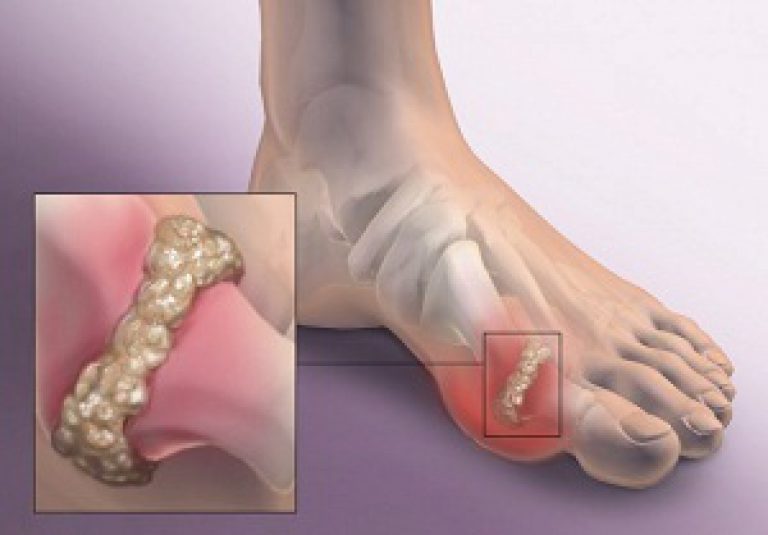
Have you encountered a gout attack? After reading the material, did you realize that you are at risk? Learn measures to prevent gouty attacks, learn how to prevent the first attack of gout.
- moderate consumption of red meat, legumes, sweets, chocolate, coffee, black tea. Less often include sardines, herring, spinach, liver in the menu;
- remember: frequent consumption of beer and red wine leads to an excess of purines in the body, provokes the accumulation of urates;
- abandon a sedentary lifestyle, get rid of extra pounds;
- after 40 years, pay more attention to health, regularly examined by narrow specialists;
- after 45 years, it is important for women to control the hormonal background. Regular intake of phytoestrogens prevents joint problems arising from a lack of female hormones;
- do not overeat, do not abuse alcohol. The greatest risk of a gouty attack develops with a combination of two negative factors;
- if you feel what a gout attack is, avoid visiting a sauna, countries with a hot climate, and avoid physical overload. Often, exacerbation begins after an uncontrolled intake of diuretic compounds.
Medication for gouty arthritis is under strict medical supervision. It is forbidden to take medications on the initiative of the patient: many potent drugs have contraindications and side effects, often dose adjustment, course duration is required. With proper therapy, observing the rules of prevention, frequent relapses of gout can be avoided.
Video - review on anti-gout medications:
Attention! Only today!
These include drugs such as naproxen (sanaprox, nalgesin forte, alive, apranax), the well-known indomethacin (methindole, indocide, indobene, indotard) and other NSAIDs.
Initially, indomethacin in an acute attack of gouty arthritis is prescribed in a certain dose, after which a certain amount of the drug is taken every 6 hours. What is characteristic, the sooner you start taking indomethacin with an attack of gout, the faster you manage to stop the attack. After a day, against the background of the drug effect, the dose is gradually beginning to be reduced.
Please note: the names of the drugs and their doses are for informational purposes only! Do not try to self-medicate, this can lead to unpredictable consequences! If you experience symptoms of an acute attack of gout, be sure to consult a doctor!
Hormonal drugs (glucocorticoids)
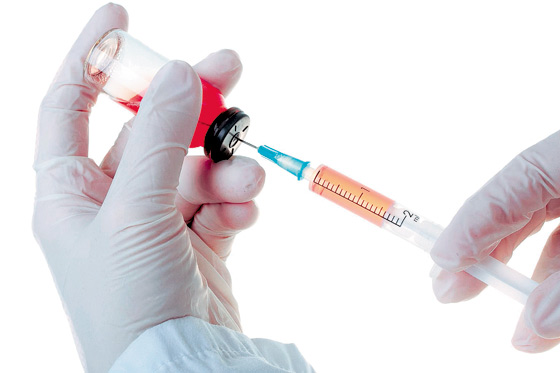
If the treatment of an acute attack of arthritis caused by gout with colchicine or non-steroidal anti-inflammatory drugs did not lead to the desired result, “heavy artillery” is used: the doctor prescribes hormones that reduce inflammation - the so-called glucocorticoid hormones.
The doctor can use single injections or short courses of drugs such as betamethasone and methylprednisolone for this. The use of such drugs can certainly reduce arthritic inflammation in gout and relieve arising pain.
Since an attack of arthritis with gout gives severe inflammation in the joint and pain, it is very important to stop such an attack as soon as possible. It usually takes no more than two days to interrupt this inflammation.
Seizure medications
After the acute attack of gouty arthritis is removed and the diagnosis is made, it's time to think about what to do next. There are special medications for the treatment of gout during nonpractical periods (which, by the way, do not work during an attack). Let's talk about them.
Purinol (allopurinol)
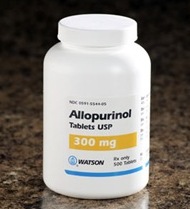 Since gouty arthritis is a disease in which there is a deposition of uric acid salts in the tissues, which accumulate in excess in the body, the doctor prescribes medications for its treatment that increase the excretion of urates from the body.
Since gouty arthritis is a disease in which there is a deposition of uric acid salts in the tissues, which accumulate in excess in the body, the doctor prescribes medications for its treatment that increase the excretion of urates from the body.
Such drugs include purinol or allopurinol. During an attack of arthritis, these drugs do not work. It is understandable, because purinol does not affect pain and inflammation in any way.
But if after the first attack you take treatment with purinol, then the likelihood of repeated attacks is significantly reduced - up to the point that after a year, with an even course of the disease, the doctor may even suggest that you gradually refuse this medicine.
Of course, the decision to cancel the therapy should be made only by the doctor based on your condition and analysis data. In no case can you independently cancel the treatment!
Folk remedies

Generous nature is rich in medicinal plants that help from a variety of ailments; There are herbs, on the basis of which you can prepare healing tinctures, lapping and compresses that help to improve well-being and gout.
Just remember that the use of medications is based on folk recipes, no matter how reliable sources they come from, it must be agreed with the attending physician and should be used not with medical treatment, but with it!
Diet
Surprised? Yes, diet can also be a cure! And if we are talking about such an metabolic disease as gout, then proper medical nutrition can even be the main assistant in recovery. It is compliance that makes it possible to control this disease and avoid further attacks of the disease.
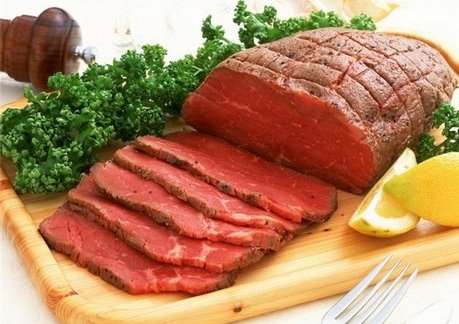
red meat is the most harmful diet in gout
The main principle of therapeutic nutrition for gouty arthritis is to avoid foods that contain a large amount of urates or substances that can turn into urates inside our body (foods with a high content of purine bases).
These foods primarily include meat, especially lamb and veal, as well as meat offal (liver, kidneys), meat broths and soups, jellied meat, some types of fish (mackerel, sardines, herring), as well as alcohol. However, products such as pasta, bread, milk and its derivatives, cheeses can be eaten without restrictions.
In fact, the mere observance of the diet in this disease can help to practically forget about this disease over time, so you should pay special attention to this information. Read more about how to eat with this disease, we wrote in the article.
As you can see, not many drugs are needed to defeat gout. The main thing that is important for this disease is not to self-medicate, consult a doctor on time and follow a proper diet.
Gout is a pathology that develops as a result of impaired purine metabolism. The disease is accompanied by the deposition of urate in the pineal glands, joints, cartilage of the auricles and is complicated by aseptic inflammation.
General information
Most pathology affects men after forty years. Often gout is a hereditary constitutional disease. Among other causes of the pathology, excessive consumption of alcohol and meat should be noted. Often, the disease is accompanied by diabetes and obesity. Disturbances in purine metabolism lead to disorders in the secretion or increased formation of uric acid, the accumulation of its salts.
Signs of pathology
For gout, the most typical are inflammatory processes in the synovial membranes, tendon sheaths, and articular bags. In the areas of deposition of urates, destruction of bone substance and cartilage tissue is noted. This, in turn, leads to subluxation and deformation of the joints. On the earlobe, in the periarticular tissue, nested urate deposits are formed - “tofi”. They are surrounded by connective tissue. Urate deposits are often found in the kidneys and other organs.
Therapeutic measures
What medications exist for what they are? What is the mechanism of their action? Is there a better cure for gout? About it further. Before speaking directly about the action of a particular drug, it should be noted that pathology is accompanied by soreness and stiffness of movements. In this regard, among other things, taking medication is aimed at eliminating these symptoms. First of all, you need to visit a specialist. The doctor, based on the patient's condition, severity, and tolerance, recommends which medications to take with gout. In the case of the development of pathology, self-medication is not allowed.
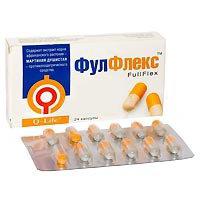
Cure for gout "Fullflex"
The price of the medication is within 200 rubles. The product is available in encapsulated form and in the form of a liniment for external application. The composition of the drug contains extracts of the bark and roots of fragrant martinia. The tool has anti-inflammatory, antimicrobial, astringent effect, exhibits decongestant effect. In the ointment, in addition to the above components, there are extracts of chestnut, fir, juniper, eucalyptus. The liniment also contains vitamins P and E. For greater effectiveness, a specialist can recommend complex treatment using both dosage forms of the medication. In this case, patients should strictly adhere to the doctor's prescriptions.
Mode of application
Capsules are recommended for patients from fourteen years old, 1 pc. once. The drug is drunk with food. Duration of use is a month. Outwardly, the medicine for gout "Fullflex", the price of which is indicated above, is applied twice a day to the affected areas. Liniment is allowed to rub lightly with massaging movements. If therapy is ineffective, one should not independently change the regimen. 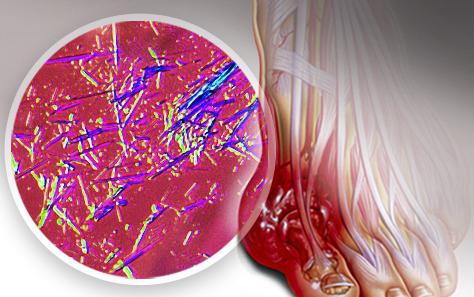
Side effect
The described medicine for gout when used can provoke bradycardia, arterial hypertension. However, it should be said that these phenomena are noted quite rarely. When taken orally, patients may experience dyspepsia, diarrhea. Against the background of therapy, hepatitis, stomatitis, and disorders in the activity of the liver are sometimes observed. The side effects that this medicine for gout causes, should also include taste disorders, neuropathy, headache, ataxia, increased fatigue, paresthesia. In some patients, the drug provokes hematuria, leukopenia, infertility, diabetes mellitus. Among the negative consequences, experts also note allergic reactions in the form of furunculosis, rash, skin irritation. Probably the drug can cause swelling, cramps, depression, drowsiness. 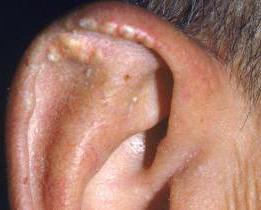
The medicine for gout "Allopurinol"
The cost of this drug varies within one hundred rubles. The medication contributes to the violation of the synthesis of the dissolution of urate deposits. This gout medicine, among other things, prevents the accumulation of uric acid salts in the kidneys and tissues. The dosage regimen is set personally. Means "Allopurinol", unlike the drug "Fulflex", is allowed for prescription in patients under 15 years of age. Adults are recommended 100-900 mg in accordance with the severity of the pathology. Take after meals 2-4 times / day. For children, the dosage is set taking into account the weight - 10-20 mg / kg. With impaired renal function, the maximum amount of medication is 100 mg. 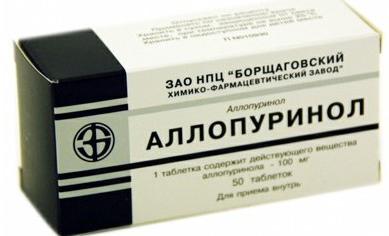
Contraindications
No medication is prescribed for pregnant women, nursing patients, patients with severe renal or hepatic impairment. Contraindications include hypersensitivity to the drug. The tool affects the speed of psychomotor reactions. In this regard, it is not recommended to engage in activities requiring increased attention.
special instructions
When taking Allopurinol, it is necessary to ensure optimal fluid intake per day - at least two liters. Dose adjustment may be required for patients with impaired liver function, thyroid hypofunction. In patients with tumor pathologies, this medicine for gout should be taken before starting therapy with cytostatics. In these cases, a minimum dosage is recommended. Due to the complex administration of the Allopurinol medication and cytostatics, regular monitoring of the state of the peripheral blood picture is necessary. During therapy, alcohol is not allowed. Asymptomatic hyperuricemia does not belong to the indications for the use of the drug. Prescribing to children is carried out only in the presence of malignant neoplasms (especially leukemia) and with some enzymatic disorders.
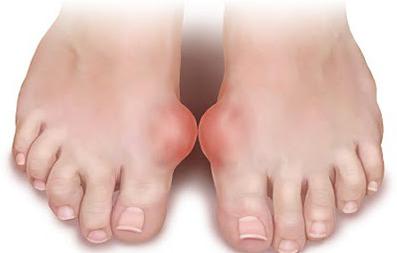
Conclusion
It should be noted that the pathology can occur atypically, not accompanied by acute attacks. In this case, changes in the joints occur gradually. Often the disease is accompanied by early atherosclerotic vascular disorders, hypertension, the formation of stones in the urinary tract. When choosing a medicine for gout, the doctor should take into account the overall clinical picture. In some cases, additional diagnostic measures may be required to prescribe adequate therapy. With a systematic and timely implementation of prevention and treatment, it is possible to stop the development of pathology and prevent acute gouty attacks. Along with drug therapy, the patient’s lifestyle and diet are of great importance.










